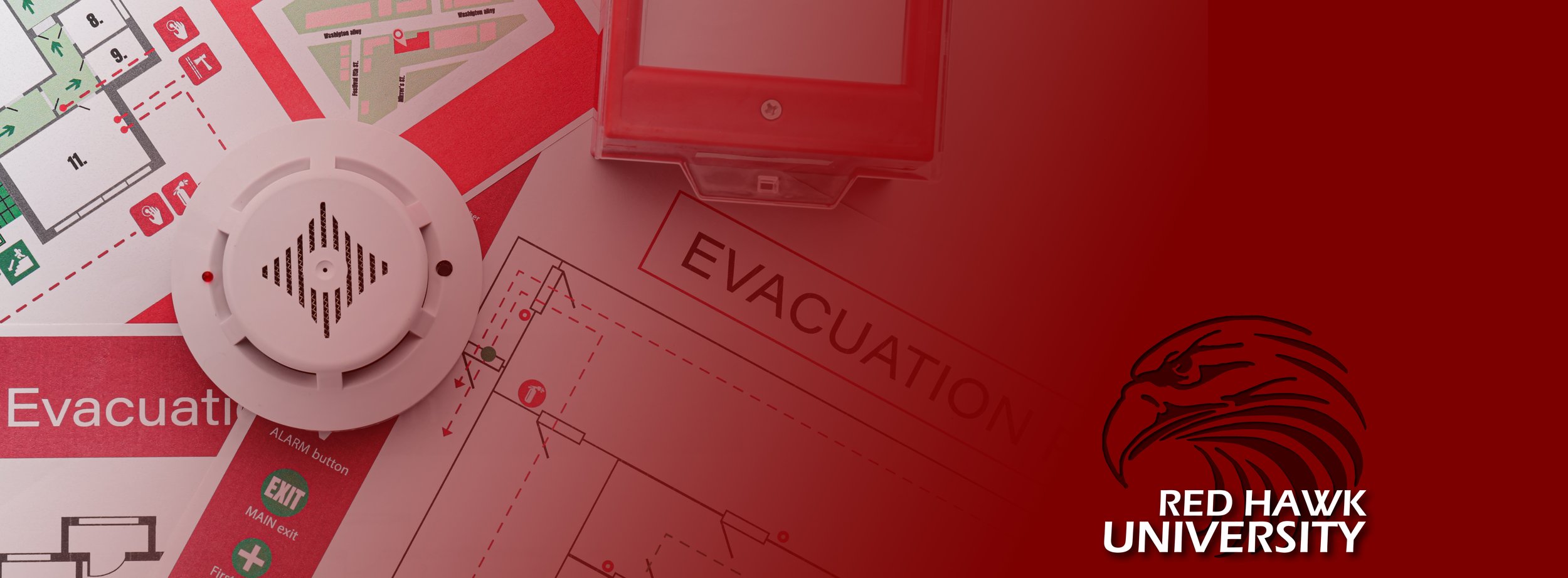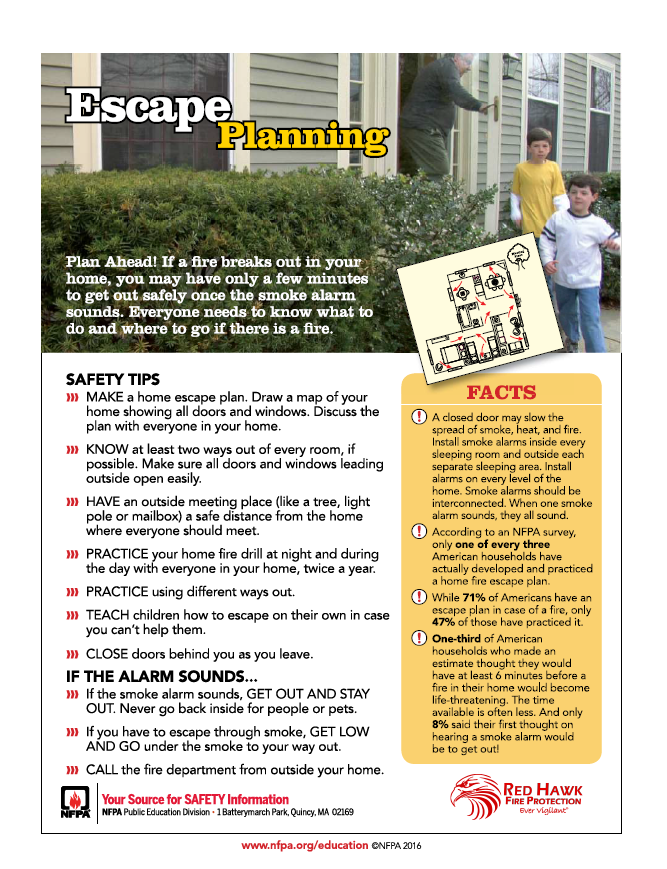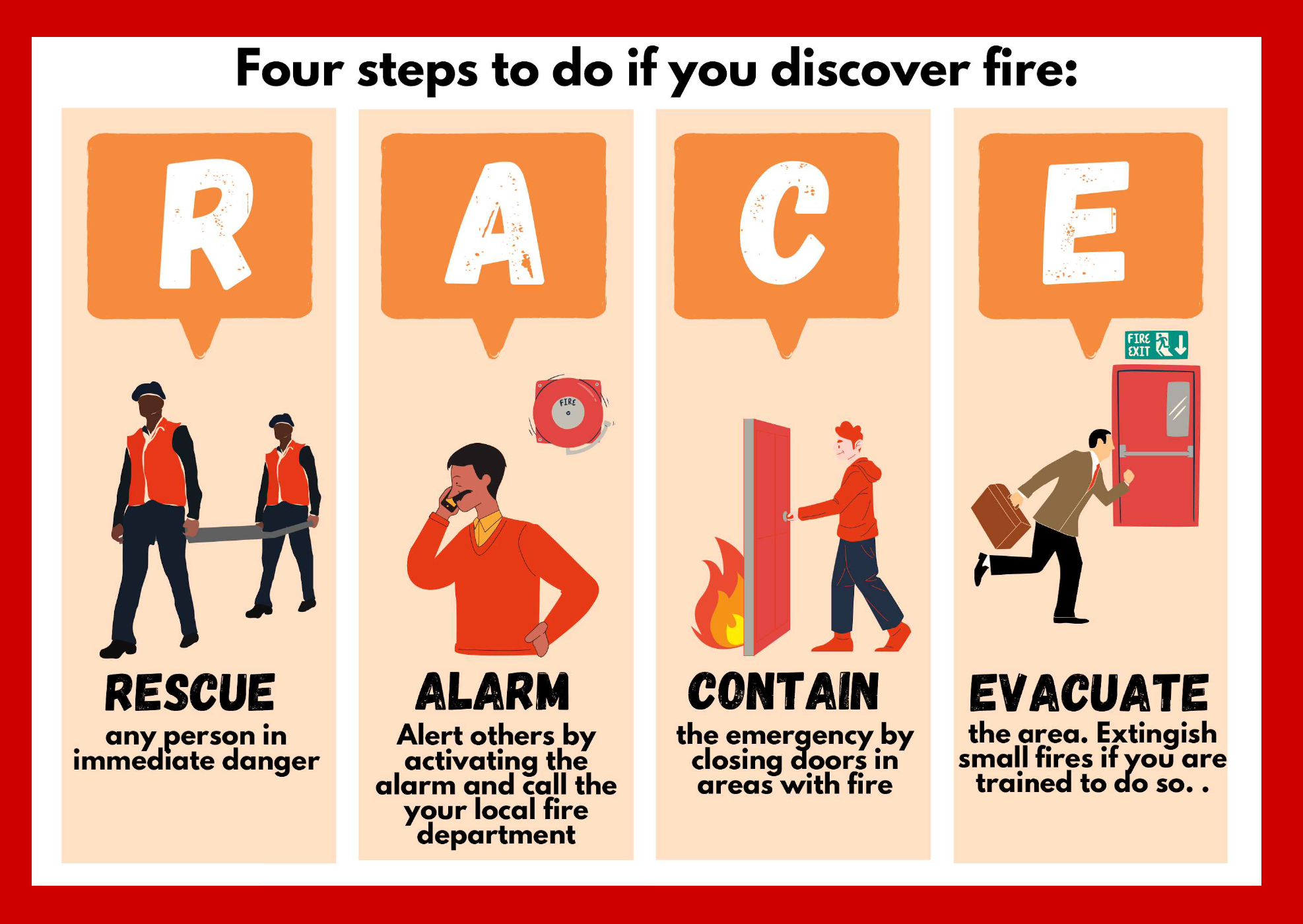
FIRE EMERGENCY PROCEDURES
Fire safety can be a complex subject to grasp, and during a fire emergency, panic can cause people to forget the necessary actions to take due to fear. Thankfully, there are various techniques available to help people remember fire safety protocols. These protocols can be useful in any fire emergency, be it at home, at work, or anywhere a fire emergency can arise.
HOME FIRE ESCAPE PLAN
Your ability to get out of your home during a fire depends on advance warning from smoke alarms and advance planning.
Fire can spread rapidly through your home, leaving you as little as one or two minutes to escape safely once the smoke alarm sounds. A closed door may slow the spread of smoke, heat and fire. Install smoke alarms in every sleeping room and outside each separate sleeping area. Install alarms on every level of the home. Pull together everyone in your household and make a plan. Walk through your home and inspect all possible exits and escape routes. Households with children should consider drawing a floor plan of your home, marking two ways out of each room, including windows and doors.
Fire Escape Planning Tips:
Gather everyone in your household and walk through the plan together.
Ensure that escape routes are clear and that doors and windows can be easily opened.
Designate a safe meeting place outside, such as a neighbor's house, a light post, a mailbox, or a stop sign.
Make sure your street number is clearly visible from the road for easy identification by emergency personnel.
Memorize the emergency phone number of the fire department and teach it to all household members.
Assign someone to assist infants, older adults, or family members with mobility limitations during fire drills and emergencies.
If your home has security bars on windows or doors, ensure they have emergency release devices for quick evacuation.
Inform guests or visitors about your family's fire escape plan, and when staying overnight at others' homes, inquire about their escape plan or offer assistance in creating one.
Once outside, do not reenter the burning building under any circumstances. Inform the fire department if anyone is missing.
Be aware of specific fire safety protocols for high-rise and apartment buildings.
By following these guidelines and being prepared for a real fire emergency, you can increase your chances of safely escaping and minimize potential harm.
Test your Fire Escape Plan:
Practice your home fire escape plan at least twice a year, ensuring that the drills are as realistic as possible. It is crucial to include arrangements in the plan for individuals with disabilities who may require special assistance. When involving children in fire drills, it is important to allow them to become proficient in fire escape planning and practice before conducting a drill at night while they are sleeping. The objective is to provide practice rather than frighten them, so informing children in advance about the upcoming drill can be just as effective as a surprise drill.
During the drill, it is essential to determine if children and others can wake up promptly to the sound of the smoke alarm. If they fail to awaken, assign someone the responsibility of waking them up as part of the drill and in a real emergency situation.
If your home consists of multiple floors, it is vital to ensure that every family member, including children, can escape from second-floor rooms. Consider using escape ladders placed in or near windows as an additional exit option. Familiarize yourself with the manufacturer's instructions to correctly and swiftly set up a safety ladder in case of an emergency. Children should only practice using the ladder under adult supervision and only from a first-story window. Store the ladder near the window in an easily accessible location to avoid searching for it during a fire.
Always select the escape route that offers the highest level of safety, minimizing exposure to smoke and heat. However, be prepared to escape through toxic smoke if necessary. During your fire drill, ensure that everyone in the family practices getting low and crawling under the smoke towards the exit.
Closing doors as you exit the building can help slow down the spread of fire, providing additional time for a safe escape.
In certain situations, smoke or fire may obstruct your path to exit your home or apartment building. To prepare for such emergencies, incorporate the practice of "sealing yourself in for safety" into your home fire escape plan. Close all doors between you and the fire, and use duct tape or towels to seal any cracks around the door. Cover air vents to prevent smoke from entering the room. If feasible, open windows at the top and bottom to allow fresh air to enter. Contact the fire department and provide them with your precise location. Wave a flashlight or a light-colored cloth at the window to alert the fire department to your whereabouts.
FIRE EMERGENCY PROCEDURES OUTSIDE THE HOME
R.A.C.E.
During a fire emergency, panic and confusion can easily overwhelm individuals, causing them to forget crucial elements of their organization's fire plan. While your workplace or healthcare team may have received training on the fire plan, it's common for important details to be forgotten in the heat of the moment. This is where the RACE acronym comes in. RACE stands for Remove, Alarm/Alert, Confine, and Extinguish/Evacuate, serving as a simple and memorable tool to navigate fire emergencies, even in times of extreme panic. Let's delve into each component of the RACE fire plan to gain a better understanding.
R - Remove/Rescue
The primary and most essential aspect of any Emergency Evacuation Plan is to ensure the safety of visitors, guests, and staff. This step should consistently be the initial action since fires have the potential to rapidly intensify, causing harm to individuals and property. Although there may be a temptation to immediately confront and extinguish the fire, prioritizing the evacuation of people must always be the utmost priority.
A - Alarm/Alert
After successfully evacuating individuals from the premises, the subsequent critical measure is to promptly notify external authorities and activate all internal alarm systems according to your organization's emergency evacuation plan:
Call 911 immediately.
If you have a manual call point or break glass alarm, or an intercom system, activate them as instructed.
C - Confine/Contain
After ensuring the safety of individuals, the subsequent step is to minimize the potential damage caused by the approaching fire. It is crucial to confine the fire, smoke, and hazardous combustibles within a specific area to the greatest extent possible. A useful method to prevent the spread of smoke is to close doors and windows, effectively restricting the oxygen supply to the fire. This containment strategy helps limit the fire's impact and reduces the risk to surrounding areas.
E - Extinguish/Evacuate
Does your team know the location of your fire extinguishers? They should be able to find the nearest equipment even if there’s smoke and darkness. In accordance with AS3745, all this information should be found on the building’s evacuation diagrams.
The acronym PASS represents the four steps of operating a fire extinguisher: Pull, Aim, Squeeze, and Sweep. This system provides clear instructions on how to effectively use a fire extinguisher and ensures the operator's safety. During a fire emergency, it is understandable to feel panicked, but if you can maintain composure and recall the PASS technique, you have a better chance of extinguishing the fire and protecting yourself and others from severe consequences. Let's look into each component of the PASS fire extinguisher technique to gain a better understanding.
P - Pull
Pulling the pin on the fire extinguisher breaks the tamper seal, indicating that the extinguisher is now prepared for use.
A - Aim
Aiming to extinguish the source of the flames, direct the fire extinguisher towards the base of the fire.
S - Squeeze
Squeezing the handle of the fire extinguisher allows for the discharge of the extinguishing agent directly at the fire.
S - Sweep
Sweeping the fire extinguisher from side to side while keeping it pointed at the base of the fire until the flames are extinguished. Exercise caution, as there is a possibility of the fire reigniting. If that occurs, repeat steps 2 to 4 to suppress the flames once again.
P.A.S.S.
In addition to following these steps, it is crucial to maintain a safe distance from the fire to minimize the risk of it growing or reigniting after initial suppression attempts. It is essential to have a predetermined evacuation route in case the fire cannot be fully extinguished. Make sure that your escape path remains clear from fire, smoke, and heat to ensure a safe exit.



